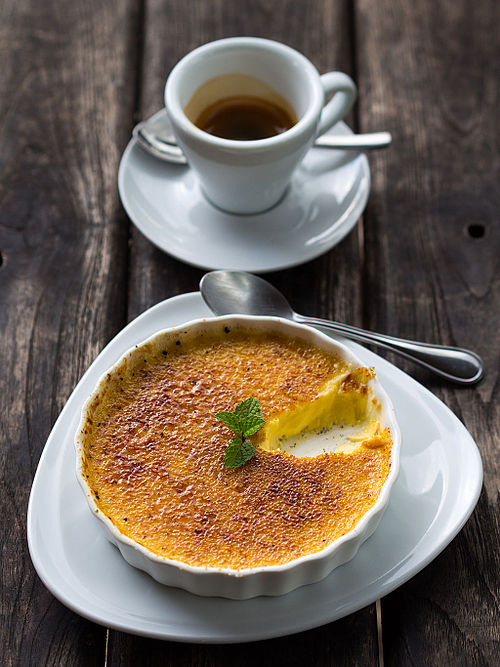Caramelization
Caramelization is a process of
Like the
When caramelization involves the
Process
Caramelization is a complex, poorly understood process that produces hundreds of chemical products, and includes the following types of reactions:
- anomericand ring forms
- sucrose inversionto fructose and glucose
- condensation reactions
- intramolecular bonding
- isomerization of aldoses to ketoses
- dehydration reactions
- fragmentation reactions
- unsaturated polymer formation
Effects of caramelization

The process is temperature-dependent. Specific sugars each have their own point at which the reactions begin to proceed readily. Impurities in the sugar, such as the molasses remaining in brown sugar, greatly speed the reactions.
| Sugar | Temperature |
|---|---|
| Fructose | 105 °C (221 °F) |
| Galactose | 160 °C (320 °F) |
| Glucose | 150 °C (302 °F) |
| Sucrose | 170 °C (338 °F) |
| Maltose | 180 °C (360 °F) |
Caramelization reactions are also sensitive to the chemical environment,[4] and the reaction rate, or temperature at which reactions occur most readily, can be altered by controlling the level of acidity (pH). The rate of caramelization is generally lowest at near-neutral acidity (pH around 7), and accelerated under both acidic (especially pH below 3) and basic (especially pH above 9) conditions.[5]
Uses in food
This section needs additional citations for verification. (February 2021) |
Caramelization is used to produce several foods, including:
- Caramel sauce, a sauce made with caramel
- Confiture de lait and dulce de leche, caramelized, sweetened milk
- Caramel candies
- Crème caramel, and the similar crème brûlée, a custard dish topped with sugar caramelized with a blowtorch
- Caramelized onions, which are used in dishes like French onion soup. Onions require 30 to 45 minutes of cooking to caramelize.[6][7]
- Caramelized potatoes
- Caramelized pears[8]
- Cola, of which some brands use caramelized sugar in small amounts for color
- Latik, a sweet syrup made of sugar and coconut milk which is used in several Filipino desserts.
- Dodol, a type of toffee made with cane sugar, rice flour, and coconut milk originating from Indonesia.
See also
References
- ISBN 978-0471175438.
- PMID 26175997.
- ^ Harold McGee. "On Food and Cooking", 2nd Edition (2004), Scribner, New York, NY. "Sugar, Chocolate and Confectionery", Page 656.
- ^ McGee, Harold. "Caramelization: new science, new possibilities". Archived from the original on October 28, 2018. Retrieved May 10, 2019.
- ISBN 978-0-8138-0378-4.
- Slate.com, May 2, 2012.
- ^ Child, Julia. "French Onion Soup". Archived from the original on May 2, 2012. Retrieved March 8, 2017.
- ^ Farley, Jennifer (October 10, 2016). "Caramelizing Pears". Stemilt. Archived from the original on February 14, 2019. Retrieved October 27, 2016.
External links
- Caramelization at Science of Cooking

